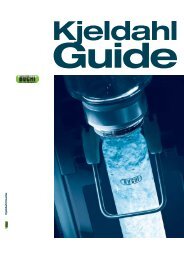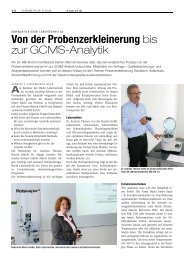The Laboratory Assistant - Buchi
The Laboratory Assistant - Buchi
The Laboratory Assistant - Buchi
You also want an ePaper? Increase the reach of your titles
YUMPU automatically turns print PDFs into web optimized ePapers that Google loves.
2.1.2<br />
Part A <strong>The</strong>oretical basis for distillation 19<br />
Boiling point, vapor pressure, and evaporation heat<br />
As already shown, a liquid transforms into the gaseous state at its boiling point.<br />
This means that no liquid can assume a temperature higher than its boiling point.<br />
Experience, of course, tells us that a liquid can also give off gas before it boils: it<br />
evaporates at far lower temperatures. When a liquid is evaporating, a few of the<br />
molecules on its surface can gather up enough energy to enable them to overcome<br />
the forces of attraction and escape into the environment as a gas. This cools<br />
the liquid, since an amount of energy is withdrawn from it. <strong>The</strong> higher the temperature,<br />
the more likely it is that a particle will be able to gather up enough energy to<br />
escape into the gas phase. <strong>The</strong> escaping molecules exert a pressure counter to<br />
the outside pressure. <strong>The</strong> more particles that can free themselves from the liquid,<br />
the higher that pressure. This vapor pressure depends upon temperature and differs<br />
from one compound to the next. It is a measurement for the volatility of a compound.<br />
Since the number of particles able to leave the liquid keeps increasing as<br />
the temperature keeps rising, vapor pressure rises rapidly with temperature. Once<br />
it becomes equal to the outside pressure, there is no longer any force present that<br />
can hold the gaseous molecules back in the fluid. <strong>The</strong> fluid starts to boil.<br />
<strong>The</strong> Clausius-Clapeyron equation shows how vapor pressure depends on<br />
temperature:<br />
(2.1) (2.2)<br />
p is the vapor pressure, T the temperature, R the universal gas constant<br />
(8.3145 J · (mol · K –1 dIn p L v<br />
L v<br />
In p = – + c<br />
dT RT RT<br />
)), and Lv the molar heat of evaporation.<br />
2<br />
=<br />
Shown in the form of a graph, Equation 2.2 appears as the straight line shown<br />
in Fig. 6. Its slope depends on the heat of evaporation. Because the heat of<br />
evaporation is largely independent of temperature and pressure, it is a constant<br />
specific to the given material. Thus, the slopes of the vapor pressure curves for<br />
different materials also differ from one another.<br />
<strong>The</strong> difference in the volatility (vapor pressures) of compounds is the critical<br />
factor that makes distillation possible. During the heating process, the more<br />
volatile components of a mixture accumulate in the vapor, and thus in its condensate<br />
as well. <strong>The</strong> French chemist François Raoult examined the dependence<br />
of vapour pressure on the composition of a component mixture. Through the<br />
investigation of mixtures from similar component mixtures (e.g. from benzene<br />
and toluene) he found that the quotient p 1/p 1* is proportional to the mole fraction<br />
(x) of solvent 1 in the liquid:<br />
Raoult's law: p 1 = p 1* · x 1<br />
Lnp<br />
L v/T<br />
Figure 6:<br />
Logarithmic graph of the<br />
vapor pressure curve.<br />
p 1 = Partial vapor pressure<br />
solvent 1<br />
p 1* = vapor pressure of pure<br />
solvent 1<br />
x 1 = mole fraction of<br />
solvent 1 in the liquid





